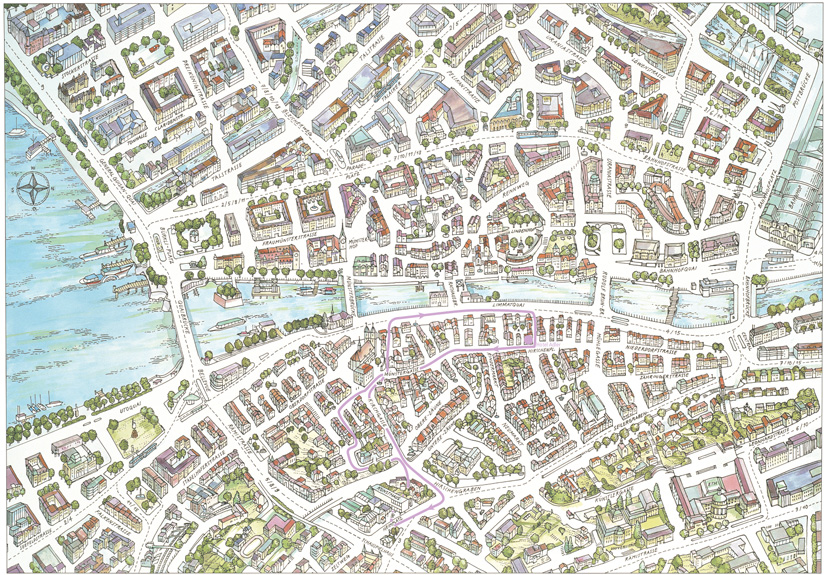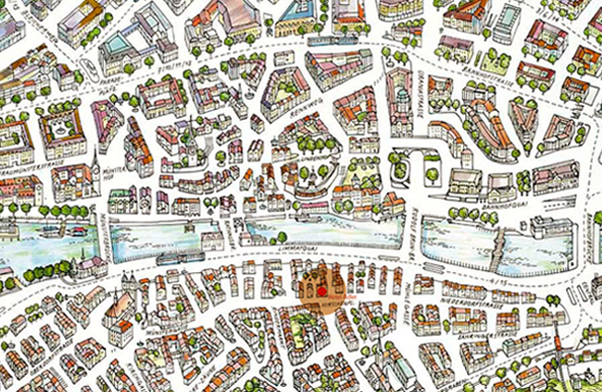Tour 2
Hirschenplatz – Münstergasse – Zwingliplatz – Grossmünster – Neustadtgasse –
Frankengasse – Winkelwiese – Heimplatz – Kirchgasse – Münstergasse – Römergasse – Limmatquai – Rosengasse – Hirschenplatz
JETZT BUCHEN
BESTER PREIS GARANTIERT
Map City Tour 2
Details: Tour 2
The Grossmünster cathedral can be reached via the Münstergasse and Zwingliplatz. With its rather unusual and impressive twin towers, Grossmünster is Zurich’s most famous landmark. Grossmünster dates back to the Carolingian period, and it was, from then until the Reformation, the seat of a canonical chapter. In 1853, a school for girls was built on the site where the Grossmünster’s collegiate institution once stood. The architect Gustav Albert Wegmann (1812– 1858) incorporated Romanesque elements into the design of this new school. To commemorate the canonical chapter, parts of the 12th-century Romanesque cloister were also integrated into the new school. Today, the school building houses the Theological Institute of the University of Zurich (the entrance can be found at Kirchgasse no. 9).
The oldest parts of the present-day Grossmünster church date back to the late 11th and early 12th centuries. After the north tower of the church was destroyed by fire in 1763, demolition of the entire church was considered, but this idea was soon rejected. In 1781, the two towers received the characteristic octagonal cupolas, which were repainted in their original colour only a few years ago. The south tower, called “Karlsturm,“ is open to visitors at certain times of the year and its parapet offers a spectacular view over the town, the valley of the Limmat, the lake and the Alps. Wilhelm Füssli, in his book “Zürich und die wichtigsten Städte am Oberrhein,“ published in 1842, already urges visitors not to miss this magnificent view.

Zwingli increasingly made enemies within the Catholic Swiss Confederation. In 1531, a civil war broke out and Zurich suffered a humiliating defeat. Zwingli was killed in the battle of Kappel. The Zwingli lodgings were situated in the “Helferei“ house at Kirchgasse no. 13. Although the house underwent successful reconstruction, including the addition of a chapel in the Neo Gothic style, a wood-panelled parlour dating back to the Reformation period exists to this day. Incidentally, Zwingli’s puritanical principles exerted a strong influence on Zurich’s population for centuries, and it is believed by some that his influence is still felt today!
The Neustadt district
The Neustadt district, one of the most charming and best preserved areas of the Old Town, is accessible to visitors via the narrow lanes Neustadtgasse, Schlossergasse, Frankengasse und Trittligasse. This small district, with its narrow houses, carries a name of which even the majority of the local population is ignorant. Why was the name Neustadt (new town) given to a historical district? In the 14th century, the area south of the Kirchgasse had not yet been developed. Only towards the end of the Middle Ages did the land between Kirchgasse und the town wall gradually begin to be used for the construction of new houses, hence the name Neustadt.
The Neustadt district is a tranquil place, inviting a moment of reflection and giving the impression that time stands still here. Today, the quiet lanes constitute a residential area. Above the front doors of the houses, stonemasons chiselled expressive names such as “zu den drei Rosen“ (the three roses), “zur Sonnenblume“ (the sunflower) or “zum Sonnenberg“ (sunny mountain). Behind the houses on the south side of the Trittligasse lie idyllic gardens of varying sizes, which are accessible however only to the inhabitants and their guests. Looking at the stone facades of the houses lining the steep Trittligasse, passers-by can only assume these hidden gardens of paradise.
There are no restaurants, no bars and no cafés to be found in the Neustadt district. This peaceful part of the town is well worth a visit since one feels protected from the bustling activity and hectic lifestyle of the city. A small square with an attractive fountain dating back to 1591 is situated at the corner of Frankengasse and Neustadtgasse. But the fountain that now stands here is not actually four hundred years old; the hexagonal basin made of limestone dates back to 1754–1755, while the fountain pillar is a faithful replica of the original pillar of 1591. The fountain figure, representing St. Nicholas, was created in 1910 by the artist Arnold Hünerwadel (see page 16). In the Swiss German vernacular, the fountain is known as “Kindlifresserbrunnen,“ meaning “fountain of the eater of small children.“ The place, where the fountain stands, offers one of the best views of the Grossmünster’s twin towers. Depending on the weather, the grey-blue towers either contrast with the sky or merge into it.
At the upper end of the Trittligasse, a nameless square provides unexpected space in the otherwise rather confined neighbourhood. Further north, at Winkelwiese no. 4, the Villa Tobler and its garden, hidden behind a tall wall, bear witness to the 19th century. In the 1960s, the villa with its unique and rich Art Nouveau interior was to be demolished. But the property was fortunately saved from destruction by the strong opposition of Zurich’s conservation society, by the commitment of the media and by the culturally minded town council of the time. The villa, whose value to the history of art went for a long time unrecognised, was eventually bought by the town and put at the disposal of theatre groups. After undergoing renovations according to the latest standards of the organisation for the preservation of historic monuments, the villa today houses the administration of the Kunsthaus (Museum of Fine Arts) and a small theatre.

The Heimplatz
Between 1875 and 1879, roads were built between Hirschengraben and Hottingerplatz as well as between Hirschengraben and Zeltweg. At the same time, the Heimplatz, today better known as “Pfauen,“ was created. There was, at that time, no indication that the area would one day become a cultural centre with both a theatre and a museum of art. However, in 1883, the new junction between the Old Town and the municipality of Hottingen gave the local population the opportunity to honour one of their fellow townsmen of outstanding merit, Ignaz Heim (1818–1880). A rather sober monument, reflecting the spirit of the time, was erected in his honour and the new square was named after him.
Ignaz Heim was a strong supporter of Swiss folk singing. He was the president of the renowned choral society “Harmonie Zürich“ and publisher of some popular song collections. The Heimplatz is a reminder that Zurich is the birthplace of traditional Swiss choral singing, a fact that has gradually fallen into oblivion. Choral singing was not just an activity pursued out of enthusiasm, but the musical expression of a belief in republican and patriotic values. Hans Georg Nägeli (1773–1836) was the founder of this art form, which developed at the beginning of the 19th century. Nägeli’s famous song “Freut euch des Lebens“ delights people to this day and gives an impression of the joie de vivre of the time.
The start of Heim’s career coincided with the time Richard Wagner spent in Zurich. Wagner’s presence had a tremendously stimulating effect on Zurich’s music scene. Wagner (1813–1883), an important innovator in opera and the creator of the music drama, was a close friend of Heim and the two were neighbours in the “Escher-Häuser,“ a series of houses located on Zeltweg. A commemorative plaque at Zeltweg no. 13 is a reminder of Wagner’s stay in Zurich and is well worth a small detour. Incidentally, at Zeltweg no. 9, a commemorative plaque points out another world-famous occupant of the “Escher-Häuser,“ the author Johanna Spyri (1829–1901), who created Heidi. The “Schweizerische Jugendbuch-Institut“ (Swiss institute for books for young people), which evolved from the “Johanna Spyri-Archiv,“ can be found at Zeltweg
no. 11.
At Heimplatz no. 1 stands Zurich’s Kunsthaus, the Museum of Fine Arts, which was opened in 1910. It houses an imposing collection of paintings and sculptures dating from the Middle Ages to modern times. The Kunsthaus also hosts temporary exhibitions, which often receive international attention.
The Schauspielhaus, Zurich’s main theatre, also situated on Heimplatz (on the adjacent Rämistrasse, to be more precise), has enjoyed an excellent reputation since the Second World War. During the war, it was the only German theatre where freedom of speech was still guaranteed.
After the war, the theatre’s international renown was ensured by the two Swiss dramatists Max Frisch (1911–1991) and Friedrich Dürrenmatt (1921–1990).
Reviews
Barry S
Google, 19.8.23
Very nice boutique Hotel. Convent to the main station and tram 4 . Maybe a ten minute walk . ( we walked upon arrival ) In a nice area of old town with many shops and restaurants steps away . Easy check in . They have complimentary water and drinks . Museum access that we took advantage of . Our room was on the top floor with a balcony . Would not consider staying anywhere else .
Sarah B
TripAdvisor, 19.8.2023
Nice location, even better people!
Anne Clarisse V
Google, 5.9.2023
Spent my birthday here and it was lovely. The fondue and raclette tasted amazing! And the staff was very friendly. They also sang happy birthday and brought out an ice cream dessert with a sparkler.
David S
TripAdvisor, 2.9.2023
Cheese fondue heaven.
Our Location
Hotel Adler Zürich
Rosengasse 10
CH-8001 Zurich
+41 44 266 96 96
info@hotel-adler.ch
Our front desk is available 24/7
Reviews
Our Partners
© Hotel Adler Zürich | Imprint | Terms & Conditions | Privacy | Voucher | Covid-19

















